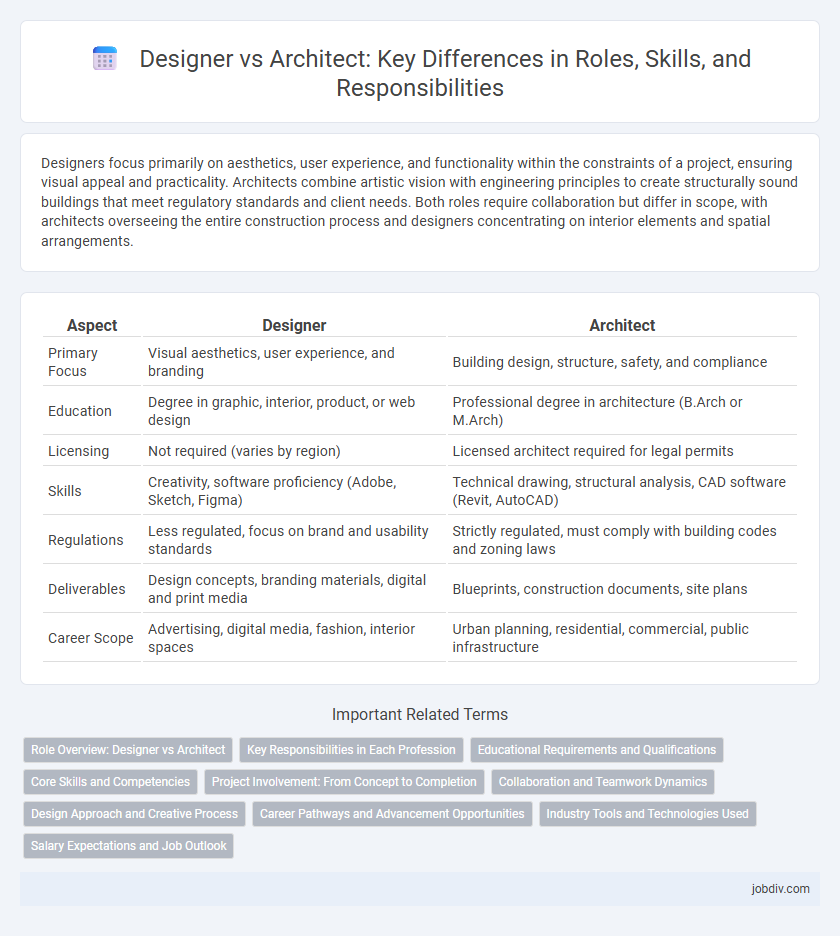Designers focus primarily on aesthetics, user experience, and functionality within the constraints of a project, ensuring visual appeal and practicality. Architects combine artistic vision with engineering principles to create structurally sound buildings that meet regulatory standards and client needs. Both roles require collaboration but differ in scope, with architects overseeing the entire construction process and designers concentrating on interior elements and spatial arrangements.
Table of Comparison
| Aspect | Designer | Architect |
|---|---|---|
| Primary Focus | Visual aesthetics, user experience, and branding | Building design, structure, safety, and compliance |
| Education | Degree in graphic, interior, product, or web design | Professional degree in architecture (B.Arch or M.Arch) |
| Licensing | Not required (varies by region) | Licensed architect required for legal permits |
| Skills | Creativity, software proficiency (Adobe, Sketch, Figma) | Technical drawing, structural analysis, CAD software (Revit, AutoCAD) |
| Regulations | Less regulated, focus on brand and usability standards | Strictly regulated, must comply with building codes and zoning laws |
| Deliverables | Design concepts, branding materials, digital and print media | Blueprints, construction documents, site plans |
| Career Scope | Advertising, digital media, fashion, interior spaces | Urban planning, residential, commercial, public infrastructure |
Role Overview: Designer vs Architect
Designers focus on conceptualizing and creating visual solutions, often specializing in areas such as graphic, interior, or industrial design. Architects are licensed professionals responsible for planning, designing, and overseeing the construction of buildings, ensuring compliance with safety codes and regulations. While designers emphasize aesthetics and user experience, architects integrate structural integrity, functionality, and legal requirements into their projects.
Key Responsibilities in Each Profession
Designers focus on creating aesthetically appealing and functional spaces, emphasizing interior layouts, color schemes, and materials to enhance user experience. Architects are responsible for the structural integrity, safety, and compliance of building designs, overseeing site planning, building codes, and technical specifications. Both professions require collaboration but differ in scope, with architects handling overall building design and designers concentrating on interior environments.
Educational Requirements and Qualifications
Designers typically pursue a bachelor's degree in design, fine arts, or a related field, with some specializing through certifications in user experience or graphic design. Architects must obtain a professional degree in architecture accredited by the National Architectural Accrediting Board (NAAB), complete a rigorous internship through the Architectural Experience Program (AXP), and pass the Architect Registration Examination (ARE) to become licensed. The extensive educational pathway for architects emphasizes technical knowledge, building codes, and structural integrity, while designers focus more on creativity, aesthetics, and user interaction.
Core Skills and Competencies
Designers excel in creativity, visual communication, and user experience, mastering software like Adobe Creative Suite to craft aesthetically appealing and functional spaces or products. Architects possess deep expertise in structural engineering, building codes, and project management, ensuring designs are safe, feasible, and compliant with regulations. Both professions require strong problem-solving abilities, but architects integrate technical and regulatory knowledge with design principles, while designers prioritize innovation and conceptual development.
Project Involvement: From Concept to Completion
Designers primarily focus on the creative aspects of a project, developing initial concepts, aesthetics, and user experience details. Architects oversee the entire process from concept through construction, ensuring structural integrity, building codes compliance, and coordination with contractors. Their involvement extends into project management, site inspections, and final approvals, bridging design vision with practical execution.
Collaboration and Teamwork Dynamics
Designers and architects collaborate by merging creative vision with technical expertise to deliver innovative and functional spaces. Effective teamwork dynamics emphasize clear communication, mutual respect, and an understanding of each role's strengths in project planning and execution. Leveraging complementary skills ensures cohesive designs that meet both aesthetic goals and regulatory requirements.
Design Approach and Creative Process
Designers emphasize user-centered aesthetics and functionality, employing iterative sketching and prototyping to refine concepts quickly. Architects integrate structural integrity and regulatory compliance, balancing creative vision with technical constraints through detailed modeling and site analysis. Both disciplines prioritize innovation but differ in scope, with architects addressing macro-scale environments while designers focus on micro-scale visual and experiential elements.
Career Pathways and Advancement Opportunities
Designers typically enter the creative industry through specialized training in graphic, interior, or product design, with career advancement often leading to roles such as Senior Designer, Art Director, or Creative Director. Architects follow a structured path requiring a professional degree in architecture, licensure exams, and gaining experience through internships, progressing towards positions like Project Architect, Senior Architect, or Principal Architect. Both career pathways offer opportunities for leadership, specialization, and independent practice but differ significantly in required credentials, regulatory scope, and project responsibilities.
Industry Tools and Technologies Used
Designers typically utilize software such as Adobe Creative Suite, Sketch, and Figma for creating visual concepts and user interfaces, emphasizing aesthetics and user experience. Architects rely on tools like AutoCAD, Revit, and BIM (Building Information Modeling) technologies to develop detailed architectural plans and manage construction workflows. Both professions integrate emerging technologies like VR and 3D modeling to enhance design accuracy and stakeholder collaboration.
Salary Expectations and Job Outlook
Architects typically earn higher median salaries, averaging around $80,000 annually, due to their specialized training and licensing requirements, while designers have a broader salary range between $40,000 and $70,000 depending on specialization. The job outlook for architects projects a growth rate of about 3% over the next decade, reflecting steady demand for sustainable and innovative building solutions, whereas designers face variable opportunities heavily influenced by industry trends and technology advancements. Both professions require continuous skill development, but architects generally benefit from more stable employment prospects and higher earning potential in construction and urban development sectors.
Designer vs Architect Infographic

 jobdiv.com
jobdiv.com